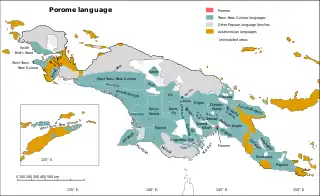| Porome | |
|---|---|
| Kibiri | |
| Native to | Papua New Guinea |
| Region | Gulf Province, Kikori District, near Aird Hills, on several tributaries of Kikori River, villages of Tipeowo, Doibo, Paile, Babaguina, Ero, and Wowa in southern Papua New Guinea |
Native speakers | 1,200 (2011)[1] |
| Dialects |
|
| Language codes | |
| ISO 639-3 | prm |
| Glottolog | kibi1239 |
| ELP | Kibiri-Porome |
 Map: The Porome language of New Guinea
The Porome language (large bay, southern PNG)
Trans–New Guinea languages
Other Papuan languages
Austronesian languages
Uninhabited | |
| Coordinates: 7°27′S 144°17′E / 7.450°S 144.283°E | |
Porome, also known as Kibiri, is a Papuan language of southern Papua New Guinea.
Classification
Porome was classified as a language isolate by Stephen Wurm. Although Malcolm Ross linked it to the Kiwaian languages, there is no evidence for a connection apart from the pronouns 1sg amo and 2sg do (cf. proto-Kiwaian *mo and *oro).
Distribution
There are over a thousand speakers in Babaguina (7°28′52″S 144°15′14″E / 7.480977°S 144.254009°E), Doibo (7°27′28″S 144°16′18″E / 7.45766°S 144.271731°E), Ero (7°26′46″S 144°21′53″E / 7.446131°S 144.364831°E), Paile, Tipeowo, and Wowa (7°24′51″S 144°18′56″E / 7.414287°S 144.315579°E) villages in West Kikori Rural LLG and East Kikori Rural LLG of Gulf Province, near the Aird Hills and Kikori River tributaries.[2][3]
Phonology
Porome has 9 native consonants. /s/ occurs in loanwords. There are no glottal consonants.[4]
p t k~g~ɣ b d v m n r (s)
There are five vowels, which are /a, e, i, o, u/.[4]
Like the surrounding languages, Porome is a tonal language. It has 5 tones.[4]
- High-level: kóí ‘cloth’
- Low-level: kòì ‘selfish’
- Rising: mèrí ‘road’
- Falling: mérì ‘pandanus’
- Peaking: pàkúmì ‘feather’
Pronouns
The independent pronouns and subject suffixes to the verb are as follows:
sg du pl 1 amo, -me amó-kai amó, -ke/-ki 2 do, -ke aia-kai a, -ka 3 da, -a/-bV abo-kai abo, -abo
Vocabulary
Selected Porome vocabulary from Petterson (2010):[5]
Body parts
Porome Gloss kikimi head kikimikuro hair pakai forehead ipiri kukuro eyebrow, eyelashes ipiri eye obokera ear urubi nose koropi tooth beri tongue kakimoro cheek iri hand kaka thumb iri uraka palm upuruburowara back itari back of neck (nape) eimuro breast bamakai chest bakuri belly koupuri shoulder kunei thigh murikara knee warakero leg kakapu foot
Numerals
Porome Gloss tauri 0 wakua 1 kabirai 2 wauteri 3 kaka etekaro 4 irikia wakua 5 irikia wakua, muro wakua 6 irikia wakua, muro kabirai 7 irikia wakua, muro wauteri 8 irikia wakua, muro kaka etekaro 9 irikia kabirai 10
Village and society
Porome Gloss kuri village mapi house erei fire kumapi stone wawari creek meri path penoni bridge moia men eria women kari boys mibu girls
Nature and environment
Porome Gloss bari naka sky eri ipiro sun omeri tero moon okoiri star keibu waves momoi clouds bari epu rain clouds kakaikapo, neii rain meremeri lightning marari, konobori wind ero land eii earth, soil ubi water kaku river eimuro bush erouri island moki passage pari sand oteri cliff akaburi mountain
Plants
Porome Gloss kubi tree aveiri branch kuri roots orei leaf kopo flower enenei grass avui cutty grass makai betelnut dii coconut mei sugarcane
Animals
Porome Gloss bobi pig kumi dog bari mei kumo chicken kaburi frog barami wallaby pusi cat kuiou tree kangaroo kaiani, keipari rat imai snake boribi cuscus tumaru bandicoot kana bird-of-paradise koropeiri cassowary wamo bush fowl kubeiri flying fox kapasikori black cockatoo marubo hornbill koribi fish einakerei centipede eiamu millipede morokabi spider ubatu grasshopper nepu, mati mosquito nokoiri fly enene cicada bebeiri butterfly aii sago grub buburumi sago beetle mirimabi scorpion mi crab timuri prawn vi cockle, clam keimu crocodile akouri river snake dabeouri sea turtle ketoko creek turtle watemu river turtle
Comparison
Lexical comparison of Porome with neighboring languages:[4]
gloss Porome
(isolate)Urama
(Kiwaian)Rumu
(Turama–Kikorian)Ipiko
(Anim)Folopa
(Teberan)Baimuru
(isolate)head kikimi / kikima epu wotu abe topo uku eye ipiri / ipiro idomai ihi uhino kele inamu house mapi / mapiro moto mi / ve aho be marea village kuri / kuro vati yɔ / ve vati be paʔiri place dabu / dabo vati tei vati tiki paʔiri tree kubi / kubo nuʔa i de ni iri fire erei / eria era i tae si iʔau dog kumi / kumo umu ka gaha haɔ oroko bird kumi / kumo kikio ka tipemu ba nako water ubi / uburo obo u ogo węi ere earth ei / ero hepu pɛkɛ / hapu goʔeto hae kae base makiri / makiro mabu mate kama baale ʔaia sago i / iro du kɛi du o pu 1s pronoun ámò mo i / na no e̜ na 2s pronoun do ro iki / ka vo (< ɣo) ya̜ ni 3s pronoun da nu a ete / itu / eto a̜ u 1p pronoun àmò nimo name ni da̜ ene 2p pronoun a rio kame ho dia̜ noro 3p pronoun abo ni ame iti atima oro
Comparison of Porome's phonological inventory with those of neighboring languages:[4]
References
- ↑ Porome at Ethnologue (18th ed., 2015) (subscription required)
- ↑ Eberhard, David M.; Simons, Gary F.; Fennig, Charles D., eds. (2019). "Papua New Guinea languages". Ethnologue: Languages of the World (22nd ed.). Dallas: SIL International.
- ↑ United Nations in Papua New Guinea (2018). "Papua New Guinea Village Coordinates Lookup". Humanitarian Data Exchange. 1.31.9.
- 1 2 3 4 5 Petterson, Robert. 2019. Interesting Features of Porome: An Isolate Language of PNG. Paper presented at the LSPNG 2019 Conference. 30pp.
- ↑ Petterson, Robert. 2010. Porome Daporo Avea Buka = Porome Language Picture Dictionary. Ukarumpa: SIL-PNG.
- Ross, Malcolm (2005). "Pronouns as a preliminary diagnostic for grouping Papuan languages". In Andrew Pawley; Robert Attenborough; Robin Hide; Jack Golson (eds.). Papuan pasts: cultural, linguistic and biological histories of Papuan-speaking peoples. Canberra: Pacific Linguistics. pp. 15–66. ISBN 0858835622. OCLC 67292782.